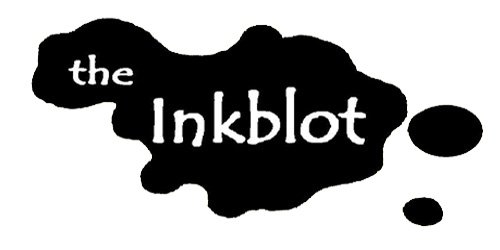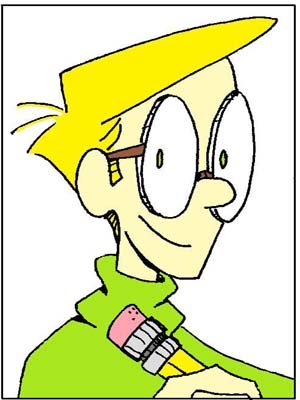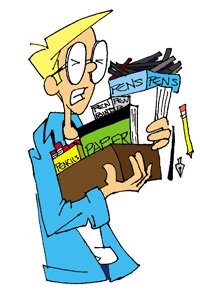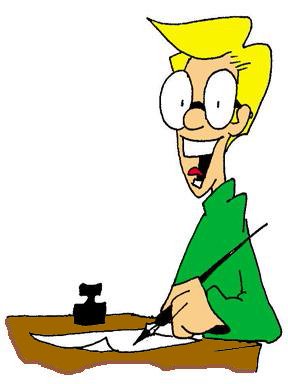
December 19, 2008
The Inkblot is your cartooning information resource. From art supplies to drawing lessons to tips from the pros, you'll learn what it takes to be a cartoonist!
If you like this ezine, please tell your friends and family about it. Remember, it's free! If this was forwarded to you by a friend, do me (and yourself) a favor and subscribe! Just click the link below:
Inkblot Subscribe Page
Contents:
- 1. Introduction
- 2. Art Supplies Review
- 3. Deciding Your Direction
- 4. Begin Your Study of Humor
- 5. A Final Word
Introduction
 Welcome to another extremely fantabulously amazingly awesome issue of The Inkblot! This issue is so insanely amazing, it will BLOW YOU AWAY! Yeah!
Welcome to another extremely fantabulously amazingly awesome issue of The Inkblot! This issue is so insanely amazing, it will BLOW YOU AWAY! Yeah!
Just kidding. But it will at least be interesting! I promise you that.
Over the next few issues, we'll discuss another must for the cartoonist: developing ideas!
But first, if this is the first issue of The Inkblot youíve read, for the last 4 issues, weíve been discussing the Essential Tools of the Cartoonist; the ones he or she just canít live without. Weíve looked at many different types of drawing tools, and have identified which ones work best for cartoonists. This is really good information that Iíve picked up during my many years of drawing cartoons, so if you havenít read these, please review them. They are available on the Inkblot Back Issues page for free! Just go to https://www.coolcartooning.com/back_issues.html.
Art Supplies Review
Now, there are a LOT more cartooning tools out there, and we have only just scratched the surface. If youíre REALLY serious about cartooning, especially if you want to become a professional cartoonist, then youíll want to look at acquiring some or all of these. Weíll discuss these in detail later, but here are some of them:
- Ruler
- T-Square
- Angles
- Exacto Knife
- Tracing Paper
- Rubber Cement
- Burnishing Bone
- Lightbox
- Drawing Board
- Ink Stand
- Liquid Paper
- Filing Cabinet
- Office Chair
- Computer
- Office/Drawing Room
For now, donít worry too much about all these things. While important, they arenít essential. To get started in drawing cartoons, all you really need is:
- Pencil
- Paper
- Pen
The last essential tool youíll need is an idea; something to draw! This may not seem like a tool at first, but itís one of the most important. You canít draw anything if you donít know what youíre going to draw.
Deciding Your Direction
Ideas can be hard to come by, especially to the newbie. Ideas can come in different ways, and everyone has their own methods. However, one thing Iíve found in my experience, is once you have a method that works for you, you have to DO IT. Like riding a bicycle, it takes practice. The more you practice getting ideas, the easier it will become. Youíll still have those tough days; some days the ideas seem to flow like a waterfall, others, they come at a trickle. But they WILL come. Unlike riding a bike, though, it can be unlearned. If you donít keep working at it regularly, then youíll lose the ability to generate those fresh ideas.But how do you go about it? What can you do to get ideas?
The first step to getting ideas for cartoons, is you have to decide what kind of cartooning you are going to do. There are many different directions can you take:
- Are you going to be a political cartoonist? Political cartoons follow the news and politics of the day, each making a particular statement, and taking a particular viewpoint. Notice that political cartoons are not always funny. They can be, but can also be serious, dramatic, sad, angry, even a bit rude, depending upon the viewpoint taken, and the subject matter involved.
- Are you going to be an illustrator? Illustrators generally work for a client. The client will generally assign the illustrator the subject matter, producing what the client wants. The end product still depends upon you, and there are always many different ways to make a drawing about the same subject appear. Illustrators work in many different capacities, such as producing work for advertising agencies and childrenís books.
- Are you going to draw a serious comic strip? There arenít many of these, but there are some, such as Prince Valiant and The Amazing Spider-Man, just to name a few. Many serious strips are weekly, many are daily, and many have multiple storylines that carry over the course of many weeks or months. These kind of cartoons arenít humorous, but you must have a continuous flow of ideas which you break into continuing stories.
- Do you want to draw a funny comic strip, or gag cartoons for magazines? Funny comic strips also sometimes have continuing stories, and sometimes stand-alone jokes, but they always must be funny. This can be difficult, because you must work up to a point where nothing but funny ideas are constantly flowing. They must be original, and high quality.
I personally prefer funny cartoons, so Iím going to talk about how to get funny ideas. Some people are funnier than others; some seem to be funny from birth, while some of us have to work at it. Being funny isnít easy, but it can be learned. You just have to be willing to have the determination, passion, and desire to put in the time and energy necessary.
Begin Your Study of Humor
Thatís right; you can learn how to be funny. But how do you do it? Well, you start with what makes you laugh. Everyone has a sense of humor, but itís not always the same. So to find out what kind of humor makes you smile, look at cartoons.A LOT of cartoons.
Read newspaper cartoons, magazine cartoons, funny greeting cards, cartoon book collections, all that you can get your hands on. And not just cartoons; read humor books, comedic novels and humor magazines also. Surround yourself with humor; eat, drink and breathe it. The more you read, the more youíll find out which kind of humor you like the best. The more youíll be able to recognize funny ideas when they come.
Once you decide what makes you laugh, narrow your reading to just that type of humor. Try to find out what it is that makes it funny. For example, really silly humor makes me laugh the most. Lucky for me, this type of humor is everywhere. One of my favorites uses itóThe Far Side. In this cartoon, animals take on human aspects, and humans do really silly things. Youíll see worms reading evening papers, cows building rocket ships, cat scientists, human scientists running after the ice cream man. Nothing youíd expect. This is why a lot of this type of humor shows up in my own cartoons.
Now, when you find a cartoonist or humorist you like and admire, study their work, but by all means, do NOT steal from them. LEARN from them. Learn the aspects and details of their humor, but donít use their actual jokes or gags. You will learn a lot by imitating a cartoonistís style, but if you steal, you wonít learn anything.
A Final Word...
Once you incorporate humor into your own life, it becomes much easier to see humor in the world around you. Watch people, pay attention to social situations, try to twist normal situations into really silly ones. Try to come up with original ideas, or new ways of looking at old ideas. Donít do too many well-known, age-old jokes, because you can only beat a dead horse for so long! In our next issue, weíll discuss more about the process of coming up with new ideas, and how to keep those creative juices flowing!
In our next issue, weíll discuss more about the process of coming up with new ideas, and how to keep those creative juices flowing!
Until then,
Happy Drawing!
Michael Richards
www.coolcartooning.com